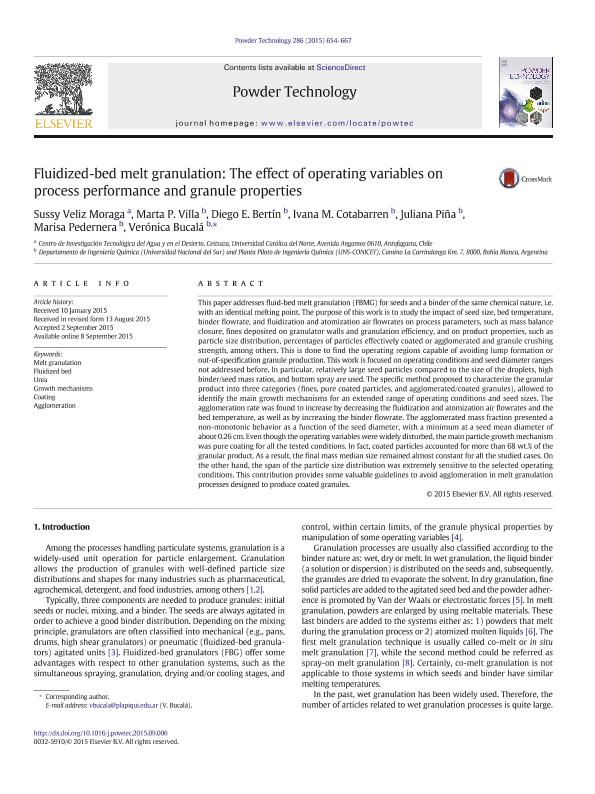Mostrar el registro sencillo del ítem
dc.contributor.author
Veliz Moraga, Sussy
dc.contributor.author
Villa, Marta Patricia

dc.contributor.author
Bertin, Diego Esteban

dc.contributor.author
Cotabarren, Ivana María

dc.contributor.author
Piña, Juliana

dc.contributor.author
Pedernera, Marisa Noemi

dc.contributor.author
Bucala, Veronica

dc.date.available
2017-09-25T15:02:28Z
dc.date.issued
2015-09-08
dc.identifier.citation
Veliz Moraga, Sussy; Villa, Marta Patricia; Bertin, Diego Esteban; Cotabarren, Ivana María; Piña, Juliana; et al.; Fluidized-bed melt granulation: The effect of operating variables on process performance and granules properties; Elsevier Science; Powder Technology; 286; 8-9-2015; 654-667
dc.identifier.issn
0032-5910
dc.identifier.uri
http://hdl.handle.net/11336/25022
dc.description.abstract
This paper addresses fluid-bed melt granulation (FBMG) for seeds and a binder of the same chemical nature, i.e. with an identical melting point. The purpose of this work is to study the impact of seed size, bed temperature, binder flowrate, and fluidization and atomization air flowrates on process parameters such as: mass balance closure; fines deposited on granulator walls and granulationefficiency; and on product properties such as: particle size distribution; percentages of particles effectively coated or agglomerated and granule crushing strength; among others. This is done to find the operating regions capable of avoiding lump formation or out-of-specification granule production.This work is focused on operating conditions and seed diameter ranges not addressed before. In particular, relatively large seed particles compared to the size of the droplets, high binder/seed mass ratios, and bottom spray are used. The specific method proposed to characterize the granular product into three categories (fines, pure coated particles, and agglomerated/coated granules), allowed to identify the main growth mechanisms for an extended range of operating conditions and seed sizes.The agglomeration rate was found to increase by decreasing the fluidization and atomization air flowrates and the bed temperature, as well as by increasing the binder flowrate. The agglomerated mass fraction presented a non-monotonic behavior as a function of the seed diameter, with a minimum at a seed mean diameter of about 0.26 cm. Even though the operating variables were widely disturbed, the main particle growth mechanism was pure coating for all the tested conditions. In fact, coated particles accounted for more than 68 wt% of the granular product. As a result, the final mass median size remained almost constant for all the studied cases. On the other hand, the span of the particle size distribution was extremely sensitive to the selected operating conditions. This contribution provides some valuable guidelines to avoid agglomeration in melt granulation processes designed to produce coated granules
dc.format
application/pdf
dc.language.iso
eng
dc.publisher
Elsevier Science

dc.rights
info:eu-repo/semantics/openAccess
dc.rights.uri
https://creativecommons.org/licenses/by-nc-sa/2.5/ar/
dc.subject
Melt Granulation
dc.subject
Fluidized Bed
dc.subject
Urea
dc.subject
Growth Mechanisms
dc.subject
Coating
dc.subject
Agglomeration
dc.subject.classification
Otras Ingeniería Química

dc.subject.classification
Ingeniería Química

dc.subject.classification
INGENIERÍAS Y TECNOLOGÍAS

dc.title
Fluidized-bed melt granulation: The effect of operating variables on process performance and granules properties
dc.type
info:eu-repo/semantics/article
dc.type
info:ar-repo/semantics/artículo
dc.type
info:eu-repo/semantics/publishedVersion
dc.date.updated
2017-05-03T20:05:03Z
dc.journal.volume
286
dc.journal.pagination
654-667
dc.journal.pais
Países Bajos

dc.journal.ciudad
Amsterdam
dc.description.fil
Fil: Veliz Moraga, Sussy. Universidad Católica del Norte; Chile
dc.description.fil
Fil: Villa, Marta Patricia. Consejo Nacional de Investigaciones Científicas y Técnicas. Centro Científico Tecnológico Conicet - Bahía Blanca. Planta Piloto de Ingeniería Química. Universidad Nacional del Sur. Planta Piloto de Ingeniería Química; Argentina
dc.description.fil
Fil: Bertin, Diego Esteban. Consejo Nacional de Investigaciones Científicas y Técnicas. Centro Científico Tecnológico Conicet - Bahía Blanca. Planta Piloto de Ingeniería Química. Universidad Nacional del Sur. Planta Piloto de Ingeniería Química; Argentina
dc.description.fil
Fil: Cotabarren, Ivana María. Consejo Nacional de Investigaciones Científicas y Técnicas. Centro Científico Tecnológico Conicet - Bahía Blanca. Planta Piloto de Ingeniería Química. Universidad Nacional del Sur. Planta Piloto de Ingeniería Química; Argentina
dc.description.fil
Fil: Piña, Juliana. Consejo Nacional de Investigaciones Científicas y Técnicas. Centro Científico Tecnológico Conicet - Bahía Blanca. Planta Piloto de Ingeniería Química. Universidad Nacional del Sur. Planta Piloto de Ingeniería Química; Argentina
dc.description.fil
Fil: Pedernera, Marisa Noemi. Consejo Nacional de Investigaciones Científicas y Técnicas. Centro Científico Tecnológico Conicet - Bahía Blanca. Planta Piloto de Ingeniería Química. Universidad Nacional del Sur. Planta Piloto de Ingeniería Química; Argentina
dc.description.fil
Fil: Bucala, Veronica. Consejo Nacional de Investigaciones Científicas y Técnicas. Centro Científico Tecnológico Conicet - Bahía Blanca. Planta Piloto de Ingeniería Química. Universidad Nacional del Sur. Planta Piloto de Ingeniería Química; Argentina
dc.journal.title
Powder Technology

dc.relation.alternativeid
info:eu-repo/semantics/altIdentifier/doi/http://dx.doi.org/10.1016/j.powtec.2015.09.006
dc.relation.alternativeid
info:eu-repo/semantics/altIdentifier/url/http://www.sciencedirect.com/science/article/pii/S0032591015300516
Archivos asociados
